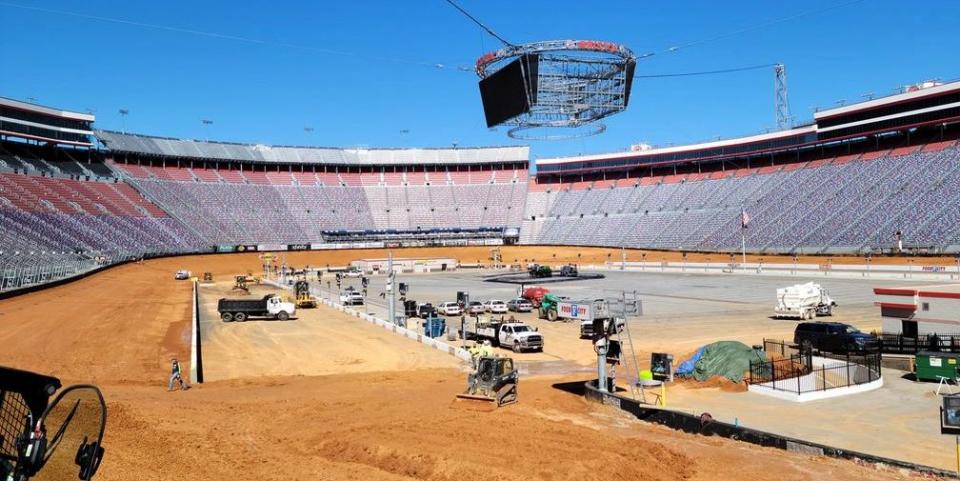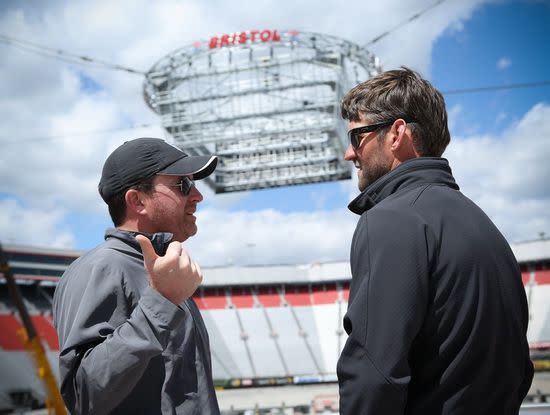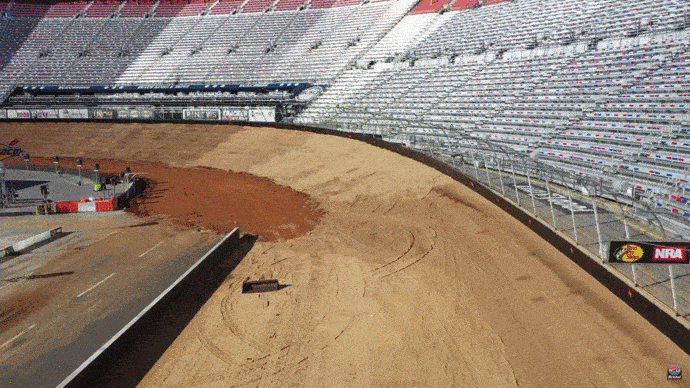How Bristol Built a Better Dirt Track

Steve Swift is in the innovation business.
It’s evident in his title, but also in his resume while serving as senior vice president of operations and development at Speedway Motorsports, Inc.
Prior to logging over 35,000 miles to visit various dirt tracks across the country in advance of his latest endeavor, Swift was also responsible for the development of a revolutionary four-lane dragstrip at zMAX Dragway in North Carolina, the renovation of the Charlotte Motor Speedway Roval and the construction of Colossus TV at Bristol Motor Speedway -- the largest center-hung LED video screen on the planet.
So, when SMI president and CEO Marcus Smith tasked him with building a better version of the temporary dirt track that once supplanted the concrete surface at Bristol ... and this time for a NASCAR Cup Series race ... it was just another day at the office.

"As an engineer, anytime you get to play in the mud while you are on the job, it’s a good day in my book," says Swift, a Bristol native. "I’ve been fortunate to work on some great projects during my time with Speedway Motorsports. When you work for visionaries like Bruton and Marcus Smith you know you are going to be engaged in some intriguing projects.
"Converting Bristol Motor Speedway to dirt is one of those challenging, but fun projects."
It’s been done before, of course, with Bristol hosting the World of Outlaws for a pair of events in 2000 and 2001, but much has changed to both complicate and simplify the process over the following two decades.
Such an event hasn’t taken place since 2001 because it’s an incredibly complicated and expensive project.
Overall, it required 23,000 cubic yards of dirt in the form of 2,300 truckloads of compacted dirt, placed in specific locations using Global Satellite Positioning (GPS) equipment on the bulldozers and graders working the job. That’s one example of how this project has been streamlined from 20 years ago.
"There is a GPS system on our dirt moving equipment that is talking to roughly 26 to 30 satellites at a time that are relaying positioning information in correlation to where on the track the blade needs to be," Swift said. "With the GPS system it gives us an accuracy within five-hundredths of an inch. You are talking about the fineness of a hair. It’s quite amazing technology actually."
The concrete surface below the temporary dirt track has also changed over the past 20 years.
A 2007 resurfacing reduced the banking from a listed 36 degrees to a 24-28 progressively steeped with wider aprons. The 2000-01 dirt track featured 21 degrees banking once the project was completed. This time, 9-10' of dirt was installed to bring the banking to 19 degrees with the goal of creating more competitive racing. Without the SAFER Barrier, the entire racing surface on the track will be about 50' wide.
This was done through additional advances in the simulation department.
The project began in January when a mountain of sawdust was spread around the half-mile racing surface.

"The reason we did that was to make sure that we when we clean the track up we have a way to get it off without staining the concrete and get the track ready for the (NASCAR) Night Race in September," Swift said. "It also helps with the cleanup."
Afterwards, the construction team added a layer of fill dirt, which was actually the same clay used on the 2000 and 2001 World of Outlaws racing surfaces at Bristol. That clay was being stored at a facility a few miles from the track and hauled in via 1,500 truckloads. The second layer came from the Gentry Campground across the street.
The racing surface was given the most consideration, and that’s why Swift devoted so much air travel over the past six months.
"Visited a lot of dirt tracks," Swift said. "Went to a lot of dirt races to educate ourselves a little bit more on all the nuances behind dirt.
"The Cup Series has not been on dirt in a long time, so (there was) nothing to go watch (to) see how that reacts, what that does. So, a lot of dirt racing (and) a lot of late model races, sprint car races (and) local tracks to get a feel for the type of dirt we'd be experiencing here in Bristol without having to haul it from Iowa and getting some of that good black dirt.
"We're dealing with nice, good red dirt that we have in northeast Tennessee."
It helped having four marquee dirt tracks in the area with Bulls Gap, Maryville, Seymour and Wytheville.
Swift sent various ‘Bluff City Clay’ samples from three different sites to a veteran California racer and promoter, Ed Hall, who rated the quality of the clay as it pertained to delivering an entertaining race.
"He analyzed the dirt and told us if it was good dirt," Swift said. "If it was bad dirt and what percentage of clay, soil and sand would make an ideal red dirt racetrack for the area we were at."
A good clay is the key to a great dirt track.
This sounds elementary to some, but for those new to dirt racing, sand is abrasive and contributes to tire wear and also creates a dusty experience during an event. It also doesn’t hold much in terms of moisture. Meanwhile, silt isn’t compactable and doesn’t allow for a sturdy racing surface.
So, the key is a dirt mixture that minimizes sand and silt, but there’s more to it, too.
"It's the alluvial and the microbial that are inside the dirt," Swift said. "So that's all the weird stuff that you hear, like horse manure that makes it live instead of dead dirt.
"I don't have a PhD in dirt, and that's why we called Mr. Hall, and he gave us that information on what we found. The ph balance of the dirt has to be at a certain level to make for good racing. Those levels were good at the location we had started digging out of."
The three sites were all no more than 30 miles away from Bristol Motor Speedway.
"The first site was really, really good, and we were excited as we got into that dirt," Swift said. "But we found a lot of bad dirt as we dug deeper, so we had to abandon that location. We took as much dirt as we could and found a third site that we were able to use to finish off the surface with."
The track was constructed by Baker's Construction in Bluff City, Tennessee with equipment provided by Meade Tractor in nearby Johnson City. Tony Harper of Line & Grade, Inc. of Ackworth Georgia designed the track.
Harper is a longtime NASCAR contractor who has worked on the construction, surfacing and resurfacing of numerous NASCAR facilities over the years. He first began working with the sanctioning body when SMI redesigned Atlanta Motor Speedway in 1996.
"Tony was the one guy that could take these really difficult racetracks and really difficult designs and see spiral curves and vertical curves and create racetracks that had good transitions and flows out of them," Swift said. "He could even help the contractors and the engineers provide data that made it to the (computer aided design) work.
"We'd have an engineer who would design the basics and then Tony would take the drawings and actually make it work as a race track. He's worked with us and NASCAR, but he's so good and fluid at what he does, that the whole industry has kind of adopted him. When we decided to put dirt on Bristol, he was the first call we made."
This week is the first test for the new racing surface with the Bristol Dirt Nationals featuring Late Models, Modifieds and various other undercard divisions. NASCAR's Brett Bodine is on-site taking notes in advance of the Truck Series and Cup Series races next weekend.
The Cup Series race will be the first to take place on a dirt surface since 1970. The race will is scheduled for 250 laps and will utilize heat races and passing points to set the starting lineup.
The Truck Series raced on dirt at Eldora Speedway from 2013-2019 and will also raced at Knoxville Raceway in Iowa on July 9.
The primary concerns, detailed here, are a track that takes too much rubber over the course of the weekend with not enough time to rework it between stages or during caution periods. The end result could be a slower version of the single-groove Bristol that was wildly popular during the 1990s.
The World of Outlaws Late Models will race on the dirt track April 9-10 and the World of Outlaws Sprint Cars will race there on April 22-24.
After that, the clean-up will begin in advance of the NASCAR Night Race weekend in September.

 Yahoo Autos
Yahoo Autos 